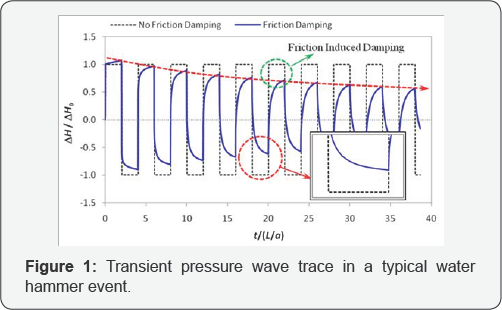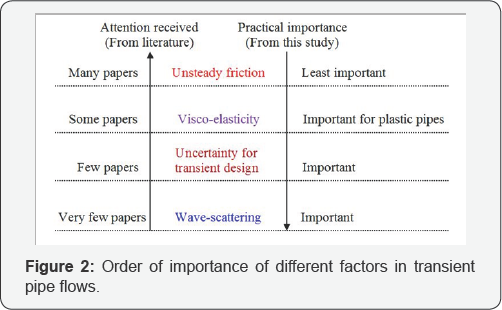Transient Flow Analysis and Utilization in Urban Water Supply Systems
Huan Feng Duan*
Department of Civil and Environmental Engineering, the Hong Kong Polytechnic University, China
Submission: September 4, 2017; Published: September 18, 2017
*Corresponding author: Huan Feng Duan, Department of Civil and Environmental Engineering, the Hong Kong Polytechnic University, Hong Kong SAR, China, Email: hf.duan@polyu.edu.hk
How to cite this article: Duan HF.Transient Flow Analysis and Utilization in Urban Water Supply Systems. Civil Eng Res J. 2017; 2(1): 555576. DOI: 10.19080/CERJ.2017.02.555576
Abstract
This paper presents a brief review on the transient flow analysis and utilization in urban water supply systems (UWSS). The advancement and progress of transient flow theory and practice are summarized and discussed with regard to the design and operation of UWSS. The opinion and recommendation on the future work and opportunities of transient flow analysis and utilization in UWSS are also provided in the end of paper.
Keywords: Transient flow; Urban water supply system; Water pipeline; Defect detection
Introduction
The transient state of flows is variously termed water hammer, fast transients, hydraulic transients, fluid transients, pressure surges, or transient waves in the water hammer literature [1]. Transient waves are fast moving elastic shocks that travel at relatively high velocities in pipeline systems (i.e., about 1000 m/s). They are generally triggered by planned or accidental events in pipe fluid systems that result in rapid changes in the pipe flow. Transient events may be caused by operations of valves, starting and stopping of pumps, variations in the supply or demand of the system fluid, and many other situations. These sudden changes in system flow require the imposition of large forces to accelerate or decelerate the fluid, and consequently are capable of inducing severe or even catastrophic pressures in the pipeline. For example, a water hammer accident caused the hydro disaster in the Russia’s biggest hydroelectric plant in 2009 [2].
In engineering practice across a multitude of fluids systems and applications, transient flows exert decisive influences on practical aspects of engineering design and operation of pipeline systems such as the structural and functional design of pipe strength and material [3]. In recent years, transient waves, either passively received or actively injected in urban water supply systems (UWSS), are widely utilized as an efficient and economic tool for pipeline condition assessment such as leakage and blockage detection [4]. The advancement and progress of these aspects of transient flows are briefly reviewed in the following sections respectively.
Transient Flow Analysis
In a practical pipeline, transient state of the flow usually occurs from an original steady state and switches to another steady state eventually due to the energy dissipation.

That is, the total energy of internal flows in pipes is dissipated with time when the transient wave propagates back and forth along the pipeline. For illustration, the pressure head signal at a specific pipeline location in a typical water hammer event is attenuated and reflected with time in the manner shown in Figure 1. In addition, the shape of the pressure wave traces is also modified by the damping factors (see enlarged picture from the circled part in Figure 1). Predicting and evaluating pressure wave damping in determining the maximum pressure envelop is important to transient system design of pipe strength and operations of hydraulic devices in pipeline systems [1,5]. On the other hand, transient wave reflections may have great influence on the flow profiles for water quality problems, such as reverse and mixing flows [6]. Meanwhile, the decay of the transient intensity of pipe flows can affect the discharge oscillation in pipes. Thus, it has impacts on the optimal design of protection devices, such as air-chambers, surge tanks, and air valves, which are used for protecting pipelines by adjusting the flow storage during transient processes [7].
Many factors in pipeline systems can affect the behaviors of transient wave damping and reflections, including unsteady friction of wall shear, visco-elasticity of plastic pipes, uncertainty of parameters, and wave-scattering of random in homogeneities. An extensive literature review shows that the unsteady friction effect has received the most attention in the past two decade, followed by the visco-elastic effect, uncertainty effect, and wave- scattering effect. However, the investigation in [8] demonstrates that, in practical pipeline systems, an opposite trend with respect to the order of importance of these four effects to transient pressure wave damping. That is, among the four effects, unsteady friction has the least contribution to the pressure wave damping, while the other three can affect more significantly the transient wave propagation in practical pipeline systems.

Figure 2 shows the ranking of importance of issues to be discussed in this work on the basis of attention received from researchers and the order of importance of these factors to practical systems as identified in previous research. In fact, the transient wave damping and reflections induced by these factors are especially critical to the utilization of transient flows for defects detection in pipelines (e.g., leakage and blockage), which is elaborated in the following section.
Transient Flow Utilization
While many practicing engineers think most often about transients referred to their negative or damaging physical effects on a pipe system, or deterioration of potable water quality, etc., there is a positive aspect to transients as an integrity management tool. Transients have the ability to acquire and transmit a significant range and variety of system information along the pipeline while travelling through the system at high speeds. This high speed transmission of information can be utilized in many practical applications, such as pipeline leak detection and condition monitoring. Leak detection continues to be more and more important to the urban water-related systems. Specifically, as transient waves move rapidly throughout a system, their waveforms are modified by their propagation and reflection interactions with the pipe and its component devices. Therefore, they can also be used as a potentially inexpensive and diverse source of information in integrity management applications [4,8]. On this point, transient pressure monitoring and analysis appears to hold considerable promise for estimating the state or condition of the pipeline system as it changes over time.
Recently developed techniques for leakage detection in water pipeline systems are utilizing the information associated with the transient damping and reflections [4,9]. Utilization of transient data for leak detection could have great practical significance
Since pipe leakage is a common, costly and serious water conservation and health issue worldwide. For example, estimates made in 2002 in Hong Kong suggest that losses in the potable water pipe system may exceed 30% of the total consumption, and a major contributor to this water loss is leakage [10]. According to information from Water Supplies Department of Hong Kong, a comprehensive pipe replacement scheme with price tag of more than US $1.3 billion started in 2000. The scheme would replace around 3,000km of pipeline within the Territory of Hong Kong mainly for reducing leakage in the water piping system [10]. Since points of leakage also represent potential locations for contaminant intrusion, identification and control of leak locations is doubly important. Consequently, an improved understanding of transient flows in pipes is important to advancing the practical utilization of transients as a source of information and, at the same time, minimizing their damaging impacts on the physical infrastructure.

Furthermore, the transient-based method has been developed and used for the detection of pipe blockages in UWSS [11]. Blockages in aging pipeline infrastructure can be caused by various reasons (see Figure 3), including corrosion, failure of pipe lining and deposition of suspended materials. Blockages in pipelines increase operational costs by reducing the flow capacity as well as large energy dissipation throughout the system [11]. Unlike leaks, the presence of blockages in a pipeline does not result in clear external indicators and the problem often remains undetected until the pipeline is close to fully constricted. Blockages are classified based on their physical extent relative to the total length of the system. Localized constrictions that can be considered as point discontinuities are referred to as discrete blockages. Common examples of this type are partially closed inline valves or orifice plates. In comparison, blockages caused by pipe aging are more common and often cover significant stretches of pipe relative to the total pipe length, which are commonly termed extended blockages in the literature.
Finally but not least, transient-based method has also been exploited for the identification and assessment of other different types of pipe defects in UWSS. For example, transient frequency response method was firstly developed and applied in [12] for detecting ill-connected branches in water supply pipe systems. Their results provided a promising alternative and tool for characterizing and identifying this type of pipe defect, which could not be well tackled by many traditional methods. Air-pocket is another issue in water pipelines that cannot be well dealt with by current methods. Based on previous studies, it is expected that the transient-based method might be useful and helpful to solve this problem, which is worthy of more investigations on this aspect in the future work.
Concluding Remarks
Transient flows are important phenomena that are commonly and frequently existent in UWSS. Understanding transient flows is critical for analyzing the structural integrity of a pipe system as well as the development of transient-based defect detection methods. Despite that various models and methods have been developed in the literature for the analysis and utilization of transient flows, it is still necessary and worthwhile to further understand and explore the mechanism and physics of transients for better design and operation of UWSS. To this end, many relevant and large-scale research projects have been launched by the governments and/or industries in different cities/regions around the world. For instance, the theme-based research scheme (TBRS) project of "Smart UWSS" sponsored by the Hong Kong Research Grants Council (RGC), with collaborations among nine leading universities from six different countries/regions, is aimed to develop the next generation of UWSS-a truly Smart UWSS [13].
Acknowledgement
The author would like to appreciate the financial support on his research work from: (1) the Hong Kong Research Grants Council under projects no. 25200616 and no. 15201017; and (2) the Hong Kong Polytechnic University under projects no. G-YBHR, no. 1-ZVGF and no. 3-RBAB.
References
- Chaudhry MH (1987) Applied hydraulic transients. Van Nostrand Reinhold Company, New York, USA.b
- (2009) Water hammer causes hydro power plant tragedy
- Duan HF, Tung YK, Ghidaoui MS (2010) Probabilistic analysis of transient design for water supply systems. Journal of Water Resources Planning and Management 136(6): 678-687.
- Colombo AF, Lee PJ, Karney BW (2009) A selective literature review of transient-based leak detection methods. Journal of Hydro-environment Research 2(4): 212-227.
- Mclnnis D, Karney BW (1995) Transients in distribution networks: field tests and demand models. Journal of Hydraulic Engineering ASCE 121(3): 218-231.
- Naser G, Karney BW (2008) A transient 2-D water quality model for pipeline systems. Journal of Hydraulic Research 46(4): 516-525.
- Jung BC, Karney BW (2006) Hydraulic optimization of transient protection devices using GA and PSO approaches. Journal of Water Resources Planning and Management ASCE 132(1): 44-52.
- Duan HF (2011) Investigation of factors affecting transient pressure wave propagation and implications to transient based leak detection methods in pipeline systems. PhD Thesis, The Hong Kong University of Science and Technology, Hong Kong, China.
- Duan HF, Lee PJ, Ghidaoui MS, Tung YK (2010) Essential system response information for transient-based leak detection methods. Journal of Hydraulic Research IAHR 48(5): 650-657.
- Burn S, De Silva D, Eiswirth M, Hunaidi O, Speers A, et al. (1999) Pipe leakage-future challenges and solutions.
- Duan HF, Lee PJ, Ghidaoui MS, Tung YK (2012) Extended blockage detection in pipelines by using the system frequency response analysis. Journal of Water Resources Planning and Management, ASCE 138(1): 55-62.
- Duan HF, Lee PJ (2016) Transient-based frequency domain method for dead-end side branch detection in reservoir-pipeline-valve systems. Journal of Hydraulic Engineering ASCE 142(2): 04015042.
- (2017) Smart urban water supply system (Smart UWSS).






























